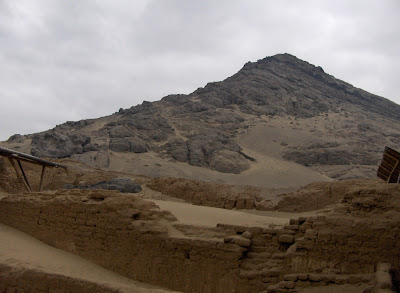That's how you say huaca as in Las huacas de la luna y del sol.
Chan Chan wasn't the only thing the Moche people built around Trujillo. The next day I was on my way to visiting Las huacas.
 |
Taking a bus (a van with an extra row of seats) to the outskirts of Trujillo.
See the large monument in the middle of the roundabout?
Doesn't it bear a striking resemblance to this piece of pottery? |
And once we hopped off the bus somewhere between a gas station and the desert, my friend led me along this small road... she called it
el camino de las huacas. In my mind I called it a road I wouldn't think to walk except for the sign promising that the
huacas were waiting for me at the end.
 |
a road to nowhere?
No, definitely somewhere! |
It wasn't long until a brigade of moto-taxis pulled up. It's a good thing my friend was there to suggest taking the moto-taxi because otherwise, it would've been a very long walk.
 |
| my first ride in a moto-taxi, outfitted in more vinyl than metal! |
Before knowing what it was, I knew that there was something special about this mountain:
 |
| my first view of Cerro blanco, or White Rock |
 |
| on small streets like this, moto-taxis are the way to go! |
 |
that rock again... I don't know, it was like a magnet
attracting the lens of my old camera |
After ten bumpy minutes of breezy moto-taxing, we arrived at the museum.
 |
not too many moto-taxis hang out at the museum and site end of the road
so it's smart to nab the mobile number of your driver.
Otherwise, you may be walking back! |
Just like Chan Chan, it pays to get acquainted with the museum before visiting the companion archaeological site. There are few English-language guides outside of Cuzco and Lima; my tour of the huacas was in Spanish.
 |
at the edge of the very modern parking lot of
Museo Huacas de Moche.
You can also see the very modern museum here.
This is a nice museum that holds a lot of really cool stuff.
You can tell because photographs were not allowed indoors. |
Huacas are sort of like step pyramids, except that they're much more than just temples. While levels were built to house some Moche kings, the huacas also allotted space for people to set up shop, trade, pray, gather... in other words it was a combination of city and tomb.
There are two huacas: the older one for the moon, a center of religious leadership, and the younger one for the sun, built when the power shifted from religious warriors to just plain old warriors. In between lay a city reserved for craftspeople, who created countless pieces of pottery, wooden and stone toys, capes, and even weapons devoted to hunting specific animals. According to all of the wonderful English translations of museum text, the Moche believed that
Cerro Blanco, the huge white mountain right behind the
huaca de la luna, housed the most powerful deity: Mountain god. In the museum he has several rows of eartherware jars dedicated to his face. Pretty popular guy...
 |
| Cerro Blanco, as seen from la huaca de la luna |
Perhaps the coolest artifact in the museum was a cat mask-cape made of metal and leather. It was worn only by the head priest-warrior, who were the elite during the heyday of the
huaca de la luna. These priest-warriors oversaw not only the ritual war games and other rituals but the interior decoration as well.
 |
| well-preserved murals inside la huaca de la luna. |
Notice how the designs on the upper and lower levels are slightly different? That's because they were painted during different times. You can also see the layers of steps... it feels like the infrastructure of the
huaca was constantly changing as new steps were being built. Today this sort of procedure would be a zoning nightmare but in the days before paperwork, all you'd need is the okay from a leader and the manpower to build it.
 |
| what conversations took place here? |
From the
huaca de la luna, you can easily see the
huaca del sol. When war generals got the upper hand over the priest-warriors, they decided that they wanted an entirely new
huaca and built the
huaca del sol. They didn't stray too far away, though; this site is centrally located between two small rivers and the Pacific Ocean, which makes for easier irrigation.
 |
| la huaca del sol |
 |
| in between, the city of craftspeople |
 |
| and in the distance, Trujillo |
It's not quite a palimpsest since all steps of the
huacas were built by the same Moche people for the same multitude of purposes but it's still visually fascinating to see the layers of adobe brick built upon each other.
It was refreshing to visit
las huacas under Trujillo's signature gray skies... somehow it felt more fitting to the Moche's militaristic lifestyle than any sunny blue sky would.
 |
| adiós, Cerro Blanco! |



















No comments:
Post a Comment